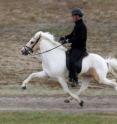A single gene has a major impact on gaits in horses and in mice
Researchers at Uppsala University, Swedish University of Agricultural Sciences and their international collaborators have discovered a mutation in a single gene in horses that is critical for the ability to perform ambling gaits, for pacing and that has a major effect on performance in harness racing. Experiments on this gene in mice have led to fundamental new knowledge about the neural circuits that control leg movements. The study is a breakthrough for our understanding of spinal cord neuronal circuitry and its control of locomotion in vertebrates. The study is being published August 29 in Nature.
Our ability to walk and run is dependent on a complex coordination of muscle contractions carried out by neuronal circuits in our spinal cord. But how does this work at the level of nerve cells and molecules? The researchers took advantage of the variability in the pattern of locomotion in horses. The three naturally occurring gaits in horses are, in order of increasing speed, walk, trot and canter/gallop. Some horses are able to perform ambling gaits and/or pace, for instance, Icelandic Horses can tölt (an ambling gait) and perform flying pace. The researchers decided to investigate the genetic basis explaining why some Icelandic Horses can pace but others cannot.
"We suspected a strong genetic component, but were almost shocked when we discovered that a single gene, DMRT3, largely explained the genetic difference between pacers and non-pacers," explains Lisa Andersson one of the PhD students involved in the project.
Independently, Klas Kullander's research group had discovered that this particular gene, DMRT3, is expressed in a previously unknown type of neurons in the spinal cord of mice. The characteristics of these neurons, including their location, suggested that they could take part in neuronal circuits coordinating movements. When the two research groups, both associated with Science for Life Laboratory in Uppsala, compared their data, they realized that an important biological finding was imminent.
"At that moment, we realized that our discovery did not only extend our understanding of spinal neuronal circuits in mouse, but that we had discovered a tangible population of nerve cells that also seemed to be critical for the control of gaits in horses. The new type of nerve cell is dependent on DMRT3, and is tentatively named after this gene," tells Klas Kullander.
The researchers demonstrated that a single base change in DMRT3, which resulted in the production of a truncated form of the DMRT3 protein, was the mutation associated with pacing in horses. They developed a diagnostic test for the mutation and discovered that it is widespread among horses that show alternate gaits like Tennessee Walking Horse from the USA and Paso Fino from South America. Moreover, to their surprise, the mutation is very common in horses bred for harness racing.
"The DMRT3 mutation shows a strong positive association with performance in harness racing, states Leif Andersson who led the hunt for the DMRT3 mutation."
As a horse increases its speed it will normally switch from trot to gallop, which is the natural gait at high speed, but this leads to disqualification for trotters.
"Our interpretation is that the mutation inhibits the transition from trot to gallop and thereby allows the horse to trot at very high speed, explains Leif Andersson."
To further explore the function of DMRT3 the researchers took advantage of the sophisticated tools of mouse neurobiology. This revealed that the DMRT3-neurons cross the midline of the spinal cord and thus connect the left with the right side, and also have a direct connection with motor neurons that control flexor and extensor muscles. The researchers also found that knockout mice, which lack a functional DMRT3 gene, have an altered pattern of locomotion.
"Without DMRT3, the neural circuit that contributes to the coordination of the limbs is not formed in a normal way," states PhD student Martin Larhammar, who participated in the characterization of the DMRT3 gene in both horses and in mice.
"At birth, these neural circuits are in a chaotic state and the mouse cannot coordinate its leg movements, but eventually other neural circuits seems to compensate for the loss of DMRT3 so that the adult mouse can again move relatively normally. This flexibility is interesting because it shows that our nervous system can adapt despite the loss of a key gene," continues Klas Kullander.
The DMRT3-mutation has had a major impact on the evolution of the domestic horse and most likely first appeared thousands of years ago. Presumably, humans discovered that some horses had a pattern of locomotion that made them particularly useful for certain purposes, such as a smoother ride provided by horses performing an ambling gait.
"The discovery of the DMRT3 mutation is an outstanding example of how genetic studies of the evolution in domestic animals can lead to basic new knowledge concerning gene function and important biological mechanisms," states Leif Andersson.
"It is truly great when this type of interdisciplinary collaboration results in such ground breaking discoveries. There was no information in the scientific literature on the function of the DMRT3 prior to the publication of our article. This protein is present in all vertebrates for which data are available, and it is likely that DMRT3 nerve cells have a central role for coordinating movements in humans as well," ends Klas Kullander.
Source: Uppsala Universitet
Other sources
- Horse gait traced to single mutationfrom News @ NatureWed, 29 Aug 2012, 18:00:34 UTC
- Single gene has major impact on gaits in horses and in micefrom Science DailyWed, 29 Aug 2012, 18:00:26 UTC
- Single gene has major impact on gaits in horses and in micefrom PhysorgWed, 29 Aug 2012, 17:02:08 UTC
